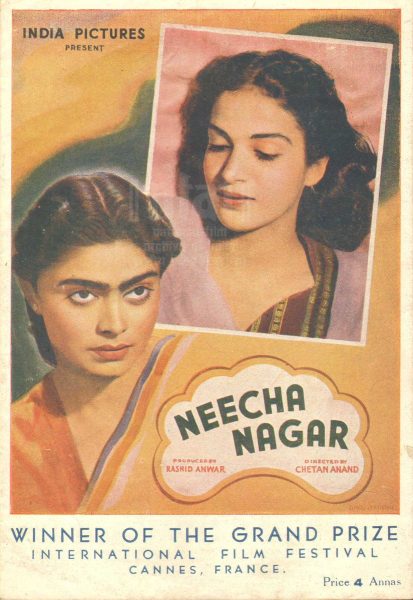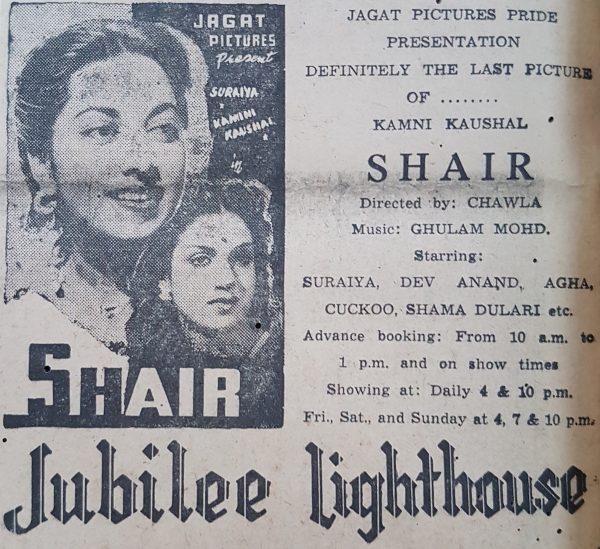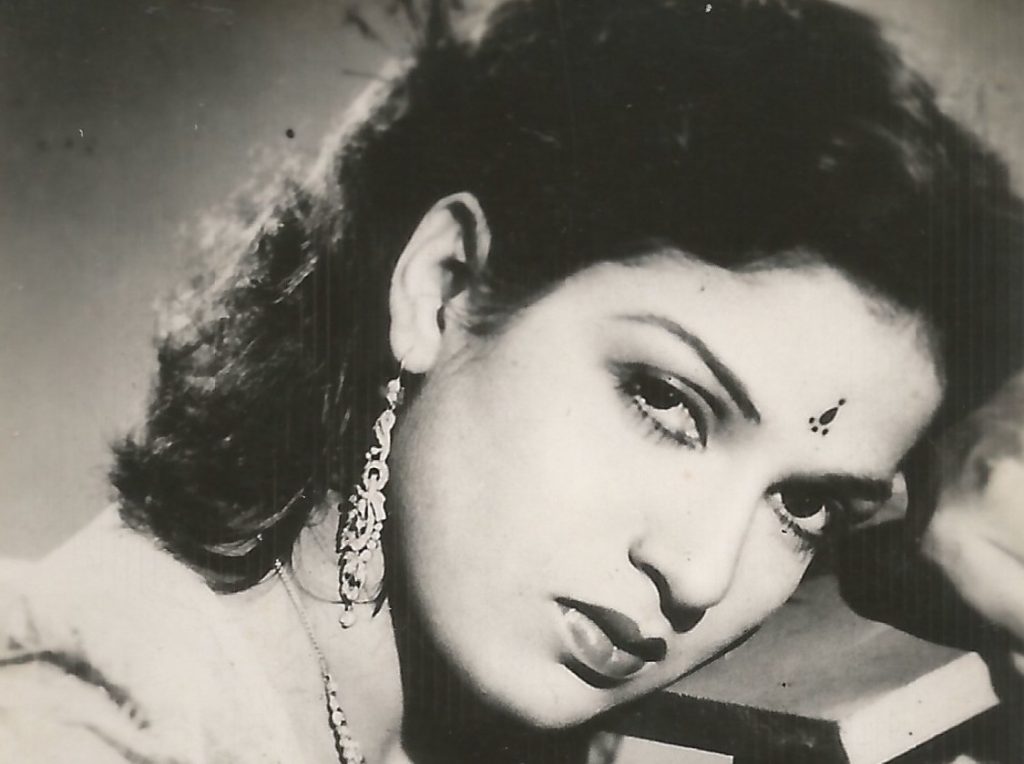Kamini Kaushal is that rare actress, who has had an acting career spanning more then seven decades. Beginning with the critically acclaimed Neecha Nagar (1946), the first ever Indian film to win the Grand Prix at Cannes to the highly successful Kabir Singh (2019), her most recent film she has been through it all. Regarded as among the early actress to bring a more natural style of acting in the world of Hindi cinema, Kaushal has given some fine performances in films like Neecha Nagar (1946), Shaheed (1948), Arzoo (1950), Biraj Bahu (1954) and Godaan (1963), her last film as a leading lady.
She was born Uma Kashyap in 1927 in Lahore, one of six children. Her eldest brother, however, passed away very young. Her father, Rai Bahadur SR Kashyap was a professor of Botany at the Government College, Lahore and at the University of the Punjab, Lahore, besides being an honorary professor at the Banaras Hindu University. Sadly for Kaushal, her father passed away due to a sudden heart-attack when she was just seven. Kaushal did her schooling at the Lady McClagan Girls’ High School and went on to do a BA Honours in English Literature from Kinnaird College, Lahore. It was while doing her college that filmmaker Chetan Anand, a friend of Kaushal’s brother, heard her on the radio – Kaushal used to do radio plays on Akashvani – and offered her a role in a film he was planning, Neecha Nagar. Initially not taking the offer seriously, she refused but as Anand persisted, she finally consented in her own words ‘for a lark’ and left for Bombay to shoot for the film.

Neecha Nagar was heavily inspired by Maxim Gorky’s The Lower Depths and Fritz Lang’s expressionist sci-fi silent classic Metropolis (1927). The film, wherein the rich live up in the mountain and the poor in the plains below in the ‘lower city’, looks at the attempts of the villain, called Sarkar, no less, to control the poor using water as a weapon. He cuts off the water supply to the lower city and diverts dirty drain water into their locality to bring disease and death to cause the poor to leave their homes so he can buy their land cheap. The film expertly combines elements of expressionism, theatre and cinema to make for a riveting film, that was way ahead of its time using off-beat camera angles, striking use of light and shade and some extremely innovative use of montage. A version with a song and all the dances edited out was sent to the Cannes Film Festival of 1946, where the film won the Grand Prix, a first for India. Sadly though, the film ran to empty houses in India though Kaushal received extremely favourable reviews for her work in the film as the sister of the hero and one of the residents of the lower city. She was also given her screen name, Kamini Kaushal, for this film as the film’s main heroine and Chetan Anand’s wife was also called Uma. Looking for a new name, Kaushal suggested something with K to go with her nieces turned daughters’ names, Kumkum and Kavita. And so Kamini Kaushal was born.
Kaushal became mother to her nieces when her elder sister died tragically in a road accident leaving behind the two young girls. For their sake, she married her brother-in-law, BS Sood, an engineer with the Bombay Port Trust (BPT). She thus returned to Bombay, where she had shot her first film. Once in Bombay, she began getting offers to act on the silver screen again. Since her husband had no issues with her acting in films, she took up the offers by signing Jail Yatra (1947) opposite Raj Kapoor and Filmistan’s Do Bhai (1947) co-starring Ulhas. The song Mera Sundar Sapna Beet Gaya, sung by Geeta Dutt, from the latter proved to be highly popular and barring the last line of the song, was shot in a single shot without cuts!
As more films followed, Kaushal was among the early actresses to work with the ‘trimurti’ that would rule Bollywood in the 1950s and first half of the 1960s – Dilip Kumar, Dev Anand and Raj Kapoor. Of these, her chemistry with Dilip Kumar was special. The two paired with each other in four films, Nadiya Ka Par (1948), Shaheed, Shabnam (1949) and Arzoo. The best of these was undoubtedly Shaheed, one of the earliest films in post-Independent India that looked at the freedom struggle against the British. In the film, Kaushal played the childhood sweetheart of freedom fighter Kumar who does all she can to prevent him from being caught by the British. Ultimately though, Kumar is caught, tried and hung. Kaushal too dies to be reunited with him in death. As the two spent much time doing these films, the inevitable happened and they fell in love. But it was a love story doomed to end in tragedy. Kaushal couldn’t walk out on her marriage and leave her young nieces whose responsibilities she had taken up. According to Producer PN Arora, Kaushal’s brother in the army threatened her on the sets of Pugree (1948), brandishing a pistol, warning her to call off the affair. It is said he similarly threatened Dilip Kumar as well! This was also the time her husband was not sure she should continue acting. She did, in fact, take a break from the film world in this period. A press advertisement of the time even advertised Shair as her last picture!

Kaushal returned to films in 1952 with the M Sadiq directed Poonam, produced again by Arora, who had earlier produced Pugree and Paras (1949) with her in the lead. Both these earlier films were directed by Anant Thakur and were written by Sadiq. While the film, co-starring Ashok Kumar, received average reviews, Kaushal was generally praised for her work in the film. Quoting. a review of the time, “Poonam is worth a visit, if only to see Kamini Kaushal stage a grand comeback. Whatever maybe the virtues or defects of “Poonam” as a kinematic offering, you will find relief in the fact that Kamini hasn’t changed. She’s as glamorous as ever and acts with confidence and gusto in a story obviously written for the exploitation of her particular talents.” It was also a rare film that exploited Kaushal’s dancing talents, trained as she was in Bharatanatyam. She also graced the cover of the very first issue of Filmfare magazine, launched that year dated March 7, 1952, and would be on the magazine’s cover again a year later on its first anniversary issue.
Post Poonam, while Kaushal reclaimed her stardom and stayed a dependable leading lady right though the ’50s, sadly, she never co-starred with the big 3 again. She either worked mostly opposite senior actors like Ashok Kumar and Kishore Sahu or did heroine centric films with the next rung of actors – Shekhar, Abhi Bhattacharya, Ranjan and Balraj (not Sahni). Her best film in this period and one that was arguably also her career best was Bimal Roy‘s adaptation of the classic Sarat Chandra Chattopadhyay novel, Biraj Bahu, wherein she played the title role. Roy made Kaushal read the novel twenty times so that Kaushal would be familiar with every nuance of the character by the time filming began. It shows in the film. Kaushal’s flawless central performance as the dutiful wife, Biraj, with its low-key smiles, its shades of anger, hurt, humiliation and shock, all come across beautifully, holding the film together. The scene where she looks into the mirror, is shocked to find all her beauty gone and says, “Achha Hi Hua” is an extremely poignant moment in the film. She would deservedly go on to win the Filmfare Award for Best Actress for the film. Interestingly, there was an announcement in Filmfare of another project where Bimal Roy was to direct Kaushal, Jagir, co-starring Balraj Sahni and Motilal, to be produced by PN Nair and with music by Anil Biswas. Sadly, the film never got made.
While Kaushal largely played the virtuous woman like Biraj in most of her films, two films where she successfully went against type in this period were the swashbuckling costume drama, Shahehshah (1953), directed by Amiya Chakravarty and filmed in Gevacolor, where she was seen in a surprisingly sexual avatar in eye-popping, cleavage-revealing costumes, and Sohrab Modi‘s Jailor (1958), a remake of his 1938 film of the same name, where she played a desperate, cheating wife to his tyrannical husband. Incidentally, Madhubala was initially cast in Shahehshah before Kaushal replaced her.
Kaushal’s last film as a heroine was Trilok Jetley’s adaptation of the Premchand novel of the same name looking at the plight of the indebted poor farmer. The film stars besides Kaushal, Raaj Kumar, Mehmood, Shubha Khote and Shashikala. Kaushal was pregnant when the offer of the film came to her but the makers, thankfully, waited for her. She responds with a fine performance as Dhaniya, a short-tempered, practical woman who does not take what she things is wrong lying down. She is fiercely protective about those she cares about and has unwavering love and loyalty to her weak, submissive but kind-hearted husband (Raaj Kumar). It is a performance that Kaushal is justifiably proud of, rating it right up there with her act in Biraj Bahu. Interestingly, the music of her first and last films as a leading lady, Neecha Nagar, and Godaan, were both scored by sitar maestro, Pandit Ravi Shankar.
Kaushal made a transition to character and motherly roles with Shaheed (1965), playing Bhagat Singh’s mother. She found the role challenging because it was unlike the stereotypical weeping, suffering Hindi film mother but instead one whose sorrow was internalised and expressed through her eyes. The film was the first ever recipient of the Best Film on National Unity and Emotional Integration, launched in the 13th edition of the National Awards, Shaheed led to a long innings of Kaushal playing the bhabhi (Do Raaste (1969), Meri Bhabhi (1969)) and the mother. In fact, she would play Manoj Kumar’s mother in several films including Upkar (1967), Yaadgar (1970), Purab Aur Paschim (1970), Shor (1972) and Roti, Kapada Our Makaan (1974). While she generally played the functional, kind-hearted mother, she was most enjoyable as and when she went against type in films like Anhonee (1973) or Prem Nagar (1974), playing not so nice characters. One interesting short but sweet mother’s role she played was as Naseeruddin Shah’s mother in Pankaj Parashar’s Jalwa (1987), where she played a character who loved the films of Dilip Kumar!
In the 1980s, Kaushal expanded her horizons to the world of Television. With an innate skill for making lovely toys and puppets, she produced the wonderful children’s series, Chandra Sitare for Doordarshan. She even directed a children’s film, Meri Pari (1986) mixing animation with live action, a forerunner she said to Who Framed Roger Rabbit? (1988). She was also seen in the prestigious British Raj series, The Jewel In The Crown (1984), playing the character of Aunt Shalini.
Following Gumrah (1993), she then took yet another break from acting in the early 1990s. However, she returned to the silver screen by end of the decade, making a smooth transition to now playing the warm and friendly grandmother in films like Har Dil Jo Pyar Karega (2000), Chori Chori (2003) and Laga Chunari Mein Daag (2007), besides the television serial Shanno Ki Shaadi (2005-6). Her last appearances on the big screen have been playing Shah Rukh Khan’s grandmother in Rohit Shetty’s Chennai Express (2013) and Shahid Kapoor’s understanding grandmother in Kabir Singh (2019). Talking about Chennai Express, she said that she just couldn’t say no to the role as she wanted to work with Shah Rukh Khan!
Kamini Kaushal is that rare artist who has lived her life to the fullest and continues to do so.


